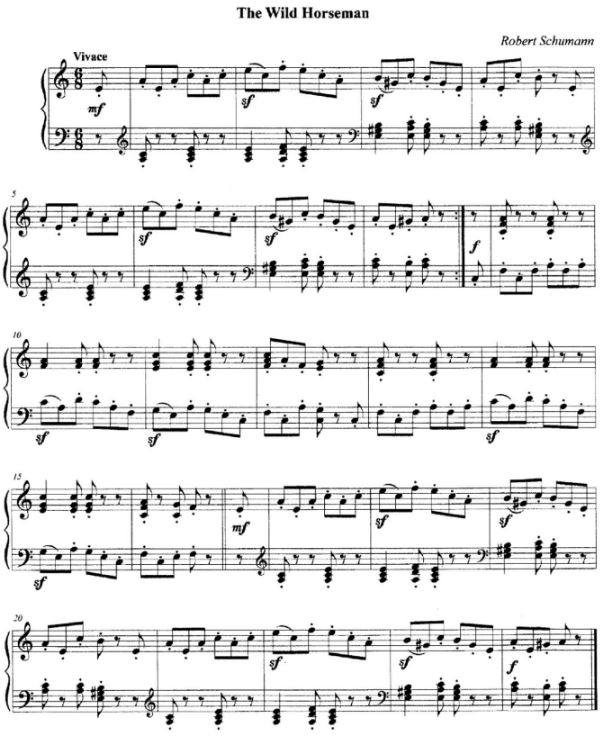SECTION A: BASIC SKILLS (30 marks)
Answer all questions in this section.
-
- Continue the following opening to make a 16-bar melody for voice. Incorporate a modulation to the relative major and return to the tonic key. (9 marks)
- Using staff notation, write a suitable melody and fit in the following text.(6 marks)
Twendeni tukacheze,
Tuimanke kiafya,
Kucheza in kuzun.
Afya zetu huboresha.
- Continue the following opening to make a 16-bar melody for voice. Incorporate a modulation to the relative major and return to the tonic key. (9 marks)
- Harmonise the following Soprano Melody by adding Alto, Tenor and Bass. Choose appropriate chorals from I, II, IV, V and VI. Incorporate a passing tone in the top voice and two cadences. (15 marks)
SECTION B: HISTORY AND ANALYSIS (54 marks)
Answer all questions in this section.
- African Music
-
- Identify three parts of an African Traditional lamellaphone, stating the role played by each part in sound production.(3 marks)
- Name one example of a lamellaphone from Kenya.(½ mark)
- Explain three features of the African Traditional folk songs that make them best suited for oral transmission(4½ marks)
- Name two examples of each of the following instruments from Kenya.
- Side-blown flutes(1 mark)
- End-blown flutes(1 mark)
- Outline four benefits of singing games to the participants.(4 marks)
-
- Western Music
Answer any two of the following questions (a), (b), (c) and (d).- Thomas Tallis
- Outline his achievements with regard to language in music at the time.(1 mark)
- State four major appointments held by Tallis during his career as a musician. (2 marks)
- Identify four types of works composed by Tallis. (4 marks)
- Wofgang Amadeus Mozart
- State two factors that promoted Mozart's musical development in childhood, (2 marks)
- Name the work whose development and popularisation is fully attributed to Mozart. (1 mark)
- Give one example of each of the following works by Mozart:
- Opera Buffa½ mark)
- Opera Seria(½ mark)
- Outline three key features of style galant' favoured by Mozart. (3 marks)
- Robert Schumann
- Schumann was famous for concentrating his energies on one form of music at a time. Identify the forms he mainly composed during the following periods:
- Before 1840.(1 mark)
- In 1840.(1 mark)
- In 1841.(1 mark)
- In 1842.(1 mark)
- State one feature of the opera 'Genoveva' (op.81) which makes it different from the traditional opera,(1 mark)
- Name two song cycles by Schumann.(2 marks)
- Schumann was famous for concentrating his energies on one form of music at a time. Identify the forms he mainly composed during the following periods:
- Aaron Copland
- State three ways in which Copland contributed to the development of music during his time.(3 marks)
- State four references on Copland's style of composition.(4 marks)
- Thomas Tallis
- Analysis of preseribed African music
"Ibodi" dance of the Baklayo-Busia Municipal Dancers (PPMC Recording)- With reference to the performance in the recording, outline five features that contribute to the creation of the climax.(5 marks)
- Describe the call-response style in the opening section of the performance.(2 marks)
- State two ways in which the voice is cued in this performance.(2 marks)
- Describe the mood of this performance.(1 mark)
- Analysis of prescribed western music
"Rondo alla Turka", Movement 3 from Piano Sonata No.11, K.331
by Wolfgang Amadeus Mozart.- With reference to specific bars. Identify the form of the opening section (Bar 1 to 24). (2½ marks)
- Identify three ways through which a sudden contrast is created between bars 32-40 in relation to the previous section.(3 marks)
- Outline the difference between bars 54-64' and '88-96'.(1 mark)
- Identify the choral progression from bar 96 to 104. Use bar numbers to illustrate your answer. (2½ marks)
- State the name given to the type of LH accompaniment between bars 110 and 116.(1 mark)
- Analysis of unprepared work
Refer to "The Wild Horseman" by Robert Schumann and answer the questions that follow.- Identify the most prevalent articulation mark used in this music.(1 mark)
- With reference to specific bar numbers, identify the general form of this music.(2 marks)
-
- Which section of the music is presented in the Major mode? Refer to bar numbers for illustration.(1 mark)
- Name the melodic feature peculiar to the section in (i) above.(1 mark)
- Describe the first chord in bar 3.(1 mark)
- State the meaning of the term "vivace" as used in the music,(1 mark)
SECTION C: GENERAL MUSIC KNOWLEDGE (16 marks)
-
- The melody below is written for Alto Saxophone in E flat. Rewrite it for clarinet in B flat to sound at the same pitch. Prefix the new key signature.(5 marks)
- State four ways through which the harmonic effect is achieved during the group performance of a traditional African folk song.(4 marks)
- Outline the meaning of the following terms as used in music.
- Embouchure(1 mark)
- Diction (1 mark)
- Producer (1 mark)
- Root (1 mark)
- Signature tune. (1 mark)
- Explain why the actual performance of the "Trio Sonata" contradicts the scoring of this work.(2 marks)
- The melody below is written for Alto Saxophone in E flat. Rewrite it for clarinet in B flat to sound at the same pitch. Prefix the new key signature.(5 marks)
(d)
Join our whatsapp group for latest updates
Tap Here to Download for 50/-
Get on WhatsApp for 50/-
Download KCSE 2016 Music Paper 1 Questions with Marking Scheme.
Tap Here to Download for 50/-
Get on WhatsApp for 50/-
Why download?
- ✔ To read offline at any time.
- ✔ To Print at your convenience
- ✔ Share Easily with Friends / Students





